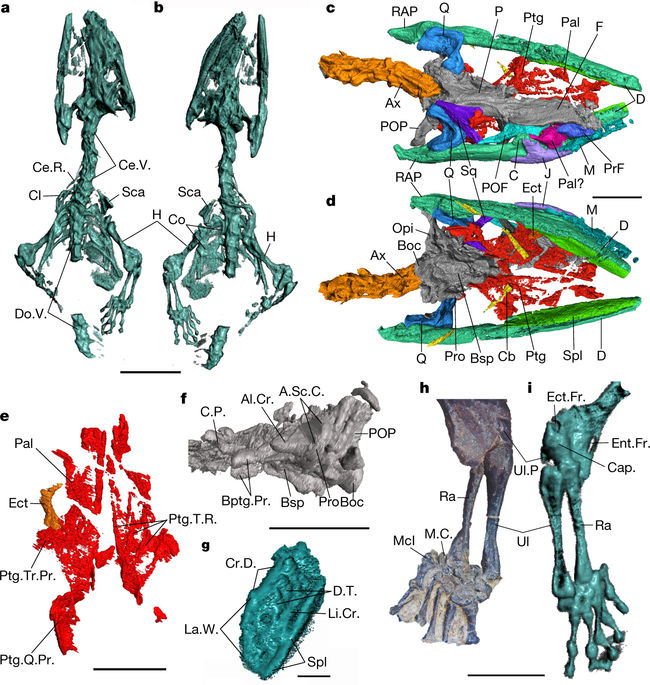Our official English website, www.x-mol.net, welcomes your
feedback! (Note: you will need to create a separate account there.)
The origin of squamates revealed by a Middle Triassic lizard from the Italian Alps
Nature ( IF 50.5 ) Pub Date : 2018-05-01 , DOI: 10.1038/s41586-018-0093-3 Tiago R Simões 1 , Michael W Caldwell 1, 2 , Mateusz Tałanda 3 , Massimo Bernardi 4, 5 , Alessandro Palci 6 , Oksana Vernygora 1 , Federico Bernardini 7, 8 , Lucia Mancini 9 , Randall L Nydam 10
Nature ( IF 50.5 ) Pub Date : 2018-05-01 , DOI: 10.1038/s41586-018-0093-3 Tiago R Simões 1 , Michael W Caldwell 1, 2 , Mateusz Tałanda 3 , Massimo Bernardi 4, 5 , Alessandro Palci 6 , Oksana Vernygora 1 , Federico Bernardini 7, 8 , Lucia Mancini 9 , Randall L Nydam 10
Affiliation

|
Modern squamates (lizards, snakes and amphisbaenians) are the world’s most diverse group of tetrapods along with birds1 and have a long evolutionary history, with the oldest known fossils dating from the Middle Jurassic period—168 million years ago2–4. The evolutionary origin of squamates is contentious because of several issues: (1) a fossil gap of approximately 70 million years exists between the oldest known fossils and their estimated origin5–7; (2) limited sampling of squamates in reptile phylogenies; and (3) conflicts between morphological and molecular hypotheses regarding the origin of crown squamates6,8,9. Here we shed light on these problems by using high-resolution microfocus X-ray computed tomography data from the articulated fossil reptile Megachirella wachtleri (Middle Triassic period, Italian Alps10). We also present a phylogenetic dataset, combining fossils and extant taxa, and morphological and molecular data. We analysed this dataset under different optimality criteria to assess diapsid reptile relationships and the origins of squamates. Our results re-shape the diapsid phylogeny and present evidence that M. wachtleri is the oldest known stem squamate. Megachirella is 75 million years older than the previously known oldest squamate fossils, partially filling the fossil gap in the origin of lizards, and indicates a more gradual acquisition of squamatan features in diapsid evolution than previously thought. For the first time, to our knowledge, morphological and molecular data are in agreement regarding early squamate evolution, with geckoes—and not iguanians—as the earliest crown clade squamates. Divergence time estimates using relaxed combined morphological and molecular clocks show that lepidosaurs and most other diapsids originated before the Permian/Triassic extinction event, indicating that the Triassic was a period of radiation, not origin, for several diapsid lineages.Computed tomography scanning of the Triassic fossil Megachirella wachtleri combined with a broad morphological and molecular phylogenetic analysis of reptile relationships confirm it as the most primitive stem squamate.
中文翻译:

来自意大利阿尔卑斯山的中三叠纪蜥蜴揭示了鳞状动物的起源
现代有鳞动物(蜥蜴、蛇和两栖动物)是世界上与鸟类一起最多样化的四足动物群1,进化历史悠久,已知最古老的化石可追溯到侏罗纪中期——1.68亿年前2-4。由于以下几个问题,有鳞动物的进化起源存在争议:(1)已知最古老的化石与其估计的起源之间存在大约 7000 万年的化石差距 5-7;(2) 爬行动物系统发育中鳞状动物的取样有限;(3) 关于冠鳞片起源的形态学和分子学假设之间的冲突 6,8,9。在这里,我们通过使用来自铰接化石爬行动物 Megachirella wachtleri(三叠纪中期,意大利阿尔卑斯山)的高分辨率微焦点 X 射线计算机断层扫描数据来阐明这些问题。我们还提供了一个系统发育数据集,结合了化石和现存的分类群,以及形态和分子数据。我们在不同的最优标准下分析了这个数据集,以评估双孔爬行动物的关系和有鳞动物的起源。我们的研究结果重新塑造了 diapsid 的系统发育,并提供了 M. wachtleri 是已知最古老的有鳞茎的证据。Megachirella 比以前已知的最古老的鳞状化石早 7500 万年,部分填补了蜥蜴起源的化石空白,表明在双孔动物进化过程中,鳞片特征的获得比以前认为的更为渐进。据我们所知,形态学和分子数据第一次与早期的有鳞动物进化一致,壁虎——而不是鬣蜥——是最早的冠状进化枝。
更新日期:2018-05-01
中文翻译:

来自意大利阿尔卑斯山的中三叠纪蜥蜴揭示了鳞状动物的起源
现代有鳞动物(蜥蜴、蛇和两栖动物)是世界上与鸟类一起最多样化的四足动物群1,进化历史悠久,已知最古老的化石可追溯到侏罗纪中期——1.68亿年前2-4。由于以下几个问题,有鳞动物的进化起源存在争议:(1)已知最古老的化石与其估计的起源之间存在大约 7000 万年的化石差距 5-7;(2) 爬行动物系统发育中鳞状动物的取样有限;(3) 关于冠鳞片起源的形态学和分子学假设之间的冲突 6,8,9。在这里,我们通过使用来自铰接化石爬行动物 Megachirella wachtleri(三叠纪中期,意大利阿尔卑斯山)的高分辨率微焦点 X 射线计算机断层扫描数据来阐明这些问题。我们还提供了一个系统发育数据集,结合了化石和现存的分类群,以及形态和分子数据。我们在不同的最优标准下分析了这个数据集,以评估双孔爬行动物的关系和有鳞动物的起源。我们的研究结果重新塑造了 diapsid 的系统发育,并提供了 M. wachtleri 是已知最古老的有鳞茎的证据。Megachirella 比以前已知的最古老的鳞状化石早 7500 万年,部分填补了蜥蜴起源的化石空白,表明在双孔动物进化过程中,鳞片特征的获得比以前认为的更为渐进。据我们所知,形态学和分子数据第一次与早期的有鳞动物进化一致,壁虎——而不是鬣蜥——是最早的冠状进化枝。











































 京公网安备 11010802027423号
京公网安备 11010802027423号